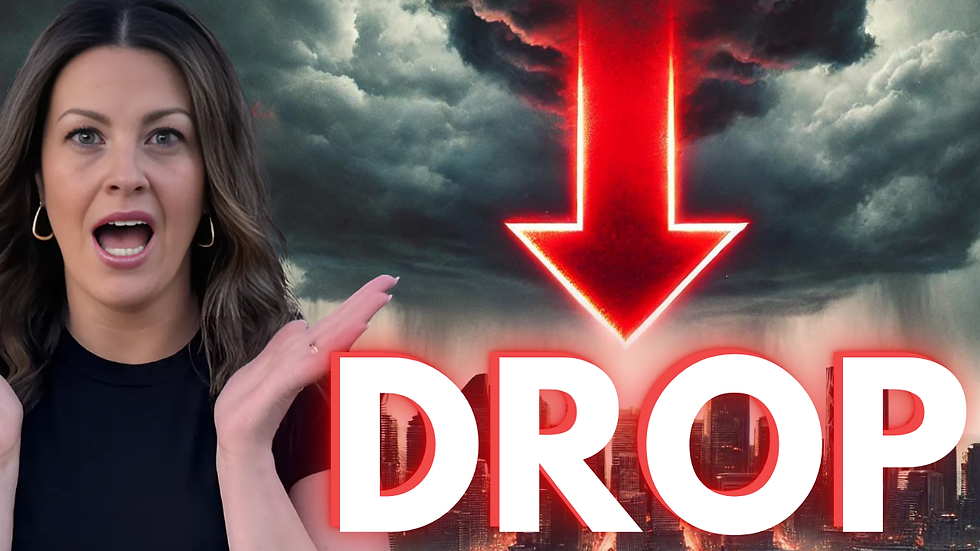Calgary Real Estate Market Update – Is This Just the Beginning of the Drop?
- Dawn Herron Maser

- Aug 14
- 4 min read

What if the market drop we’ve seen so far… is just the beginning?
That’s the question a lot of people in Calgary real estate are asking right now, and the answer isn’t as simple as the headlines make it seem. Because here’s the truth: the news often gives you one version of the story, but when you dig into the real numbers, you’ll see another.
And if you’re basing your decision to buy or sell a home on the wrong story, you could buy too soon, sell too late, and watch thousands of dollars disappear.
Even here in Calgary, not every market segment is moving in the same direction. You might think you’re getting a deal… when in reality, you could be walking straight into the next price drop.
This blog will break down the July 2025 market stats, economic trends, and what it all means for Calgary buyers, sellers, and investors.
The Bigger Economic Picture – Why It Matters for Calgary Real Estate
Before we zoom in on Calgary’s market, we have to talk about what’s happening across Canada. These big-picture trends are shaping the decisions buyers and sellers make, and they’re creating ripples in our local market.
In July, Canada lost 41,000 jobs, and nearly all of that came from full-time positions (-51,000). This is a sharp reversal from June, when the country gained 83,000 jobs. Since January, overall employment has barely moved.
Employment rate dropped to 60.7%
Unemployment rate held at 6.9%, the highest in 2025 so far
Youth employment (ages 15–24) fell sharply, with 34,000 jobs lost
Youth unemployment jumped to 14.6%, the highest since 2010
Culture and recreation lost 29,000 jobs, and construction, a key real estate driver — shed 22,000 jobs
Long-term unemployment hit 23.8%, the highest share since 1998
Alberta: The Province Hit Hardest
Alberta took the biggest employment hit in the country in July.
17,000 jobs lost in a single month, more than any other province
Employment dropped 0.6%, the sharpest decline nationwide
Unemployment rate rose to 7.8% (up 1% in one month, the largest jump anywhere in Canada)
For context:
BC lost 16,000 jobs, but unemployment rose only to 5.9%
Ontario’s unemployment is now 7.9%, Toronto’s is 9%, but their increases were more gradual
Adding to the uncertainty, Canada failed to secure a new tariff deal with the U.S. by August 1st, leaving a 35% tariff on goods not covered by the USMCA/CUSMA trade agreement. While Ontario and Quebec, political strongholds for the federal government, are bearing the brunt of this, Alberta still feels the pressure.
National Trends with Local Impact
The manufacturing and services sectors are still in contraction territory. Inflation remains sticky, GDP growth has slowed sharply, and high interest rates are squeezing both businesses and consumers.
The Bank of Canada held its overnight rate at 2.75% in July. That decision, while keeping mortgage rates stable for now, reflects the uncertainty in the economy.
The takeaway? It’s a challenging moment, but Alberta has weathered worse. We still hold key advantages in affordability, population growth, and natural resources.
Calgary Real Estate – The Numbers Behind the Headlines
Here’s where we bust one of the biggest myths: there is no single “Calgary real estate market.” We have multiple sub-markets moving in different directions.
If you read “prices are down in Calgary” in the news, that doesn’t mean every home type or every quadrant is falling in value.
For example: detached homes in the City Centre and West Calgary are actually up year-over-year, while apartments and row homes are pulling the citywide average down.
July 2025 Benchmark Prices:
Detached: $761,800 → ↓ 0.8% year-over-year (essentially flat)
Semi-detached: $697,500 → ↑ 1.4%
Row homes: $446,200 → ↓ 3.9%
Apartments: $329,600 → ↓ 4.8%
Citywide: $582,900 → ↓ 3.9%
Sales activity:
2,099 homes sold → down 11.6% year-over-year
Sales-to-new-listings ratio: 53.67% (balanced market)
Sales-to-list-price ratio: 98.03% — with 21% of buyers paying full price or more
Inventory Levels – What’s Driving Supply
In July, Calgary’s inventory sat at 6,917 units, the highest since before the pandemic. Most of this increase is in the detached market, which also has the highest sales activity.
Detached home construction is up 6.2% year-over-year, while rental development is up nearly 40%.
Apartment inventory is building faster than it’s selling, leading to sharper price declines in that segment.
Months of Supply:
Overall: 3.3 months → balanced market
Apartments: at the edge of a buyer’s market
Semi-detached & detached: just under 3 months (still leaning toward sellers)
What This Means if You’re Buying or Selling in Calgary
If you’re selling:
You can’t price like it’s early 2023. Overpricing leads to stale listings and price cuts.
Well-priced, well-prepared homes still move quickly, especially under $600K in certain areas.
If you’re buying:
More choice, especially in higher price ranges, but competition still exists in certain segments.
Waiting for “the bottom” is risky — you only know it’s the bottom once prices start climbing again.
Final Thoughts
The drop we’ve seen so far in Calgary’s real estate market could continue in certain segments, but not across the board. The buyers and sellers who do best are those who look beyond the headlines, understand the data, and act strategically.
If you want neighbourhood-specific stats or advice tailored to your situation, get in touch, I’m here to help you navigate this market with confidence.





Comments